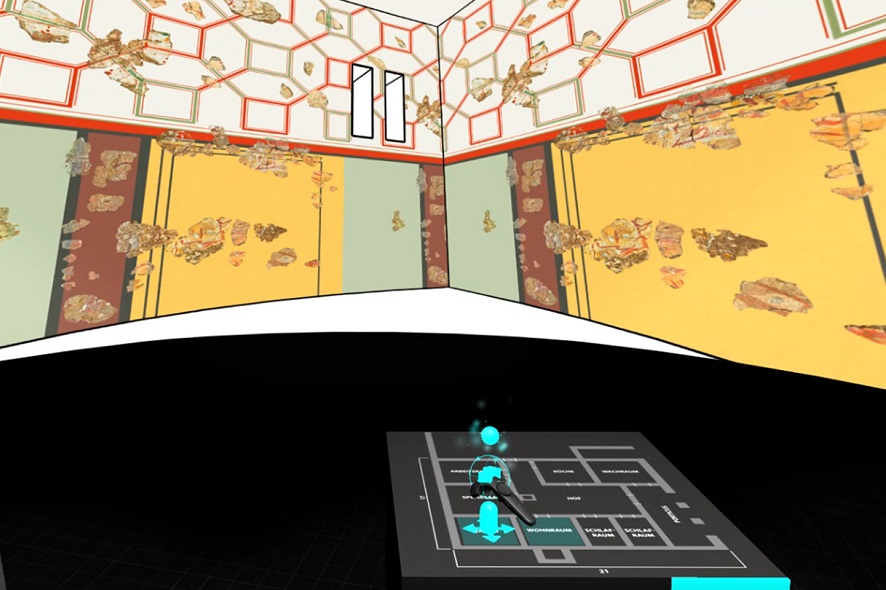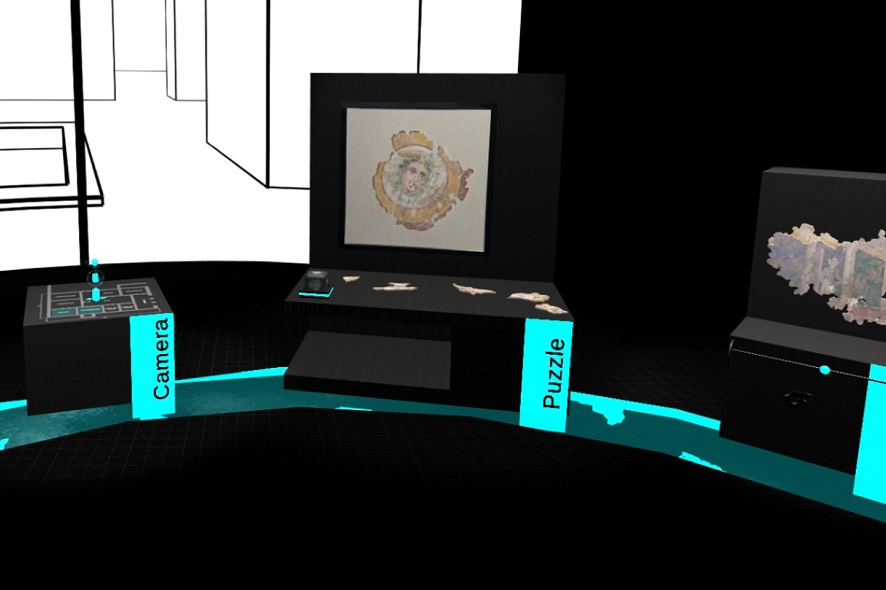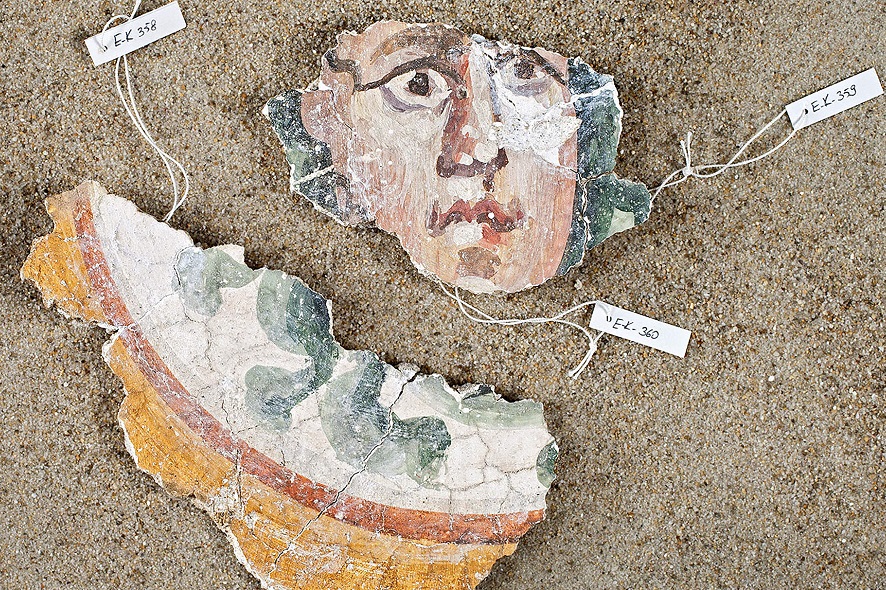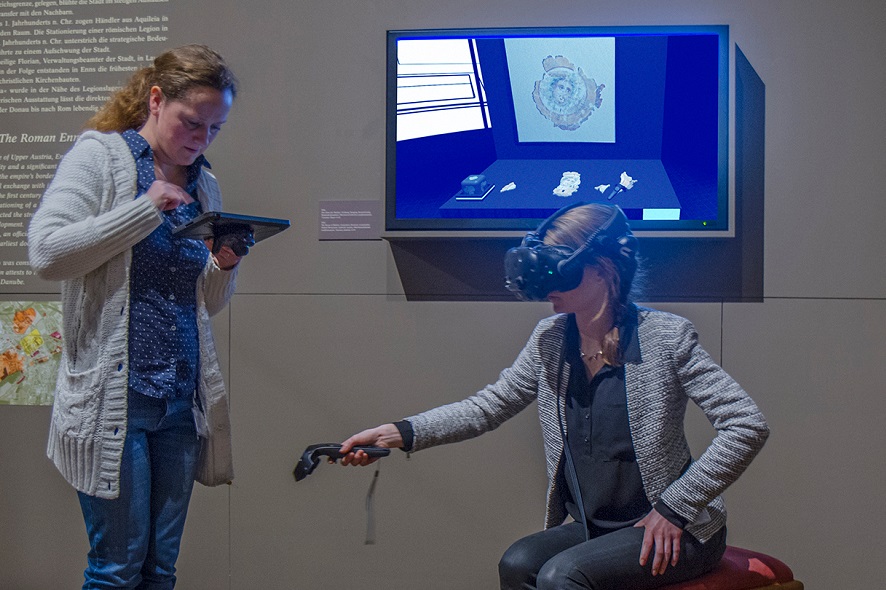This came as a complete surprise! In 2000, construction work on a new supermarket in Lorch bei Enns brought to light impressive fragments of frescoes dating back to Antiquity, when this place was named Lauriacum, a Roman town and army base. Austria’s Federal Monuments Office was notified, and carried out a rescue excavation so the fragments could be secured and carefully archived. And so they remained over a decade, virtually untouched.
Until now—in conjunction with the 2018 Upper Austria State Fair, the Playful Interactive Environments (PIE) research group at the Upper Austria University of Applied Sciences’ Hagenberg Campus has created a elaborate virtual reality (VR) installation containing for stations that enable visitors to experience there archeological finds. At the next Deep Space LIVE this coming Thursday, June 14th, Markus Santner of the Federal Monuments Office will give a talk about the “House of Medusa.” Afterwards, PIE will present its new VR installation in the Ars Electronica Center’s VRLab.
Markus Santner and PIE’s Jürgen Hagler told us more in this interview.
Why don’t you start by talking about the meaning of the title House of Medusa?
Markus Santner: The so-called House of Medusa in Lorch bei Enns got its name in 2000-01 during the archeological dig that unearthed a very high concentration of fresco fragments from the time of the Roman Empire. Ever since the 1950s, archeological staff members working on Lauriacum—whereby the considerable extent of this civilian settlement only became apparent over the course of several decades—have named the constituent buildings after particular archeological finds and characteristics. The name House of Medusa was prompted by the discovery of two depictions of a gorgon in its Roman frescoes.
Jürgen Hagler: The House of Medusa is a Roman villa that was discovered by workers excavating a supermarket parking lot in Lorch near the city of Enns, which was then on the Empire’s Danube Limes. Wall and ceiling frescoes were found, and the Federal Monuments Office was informed so they could carry out a rescue excavation. The finds were neatly archived in Vienna. During preparations for the Upper Austria State Fair, we were contacted by Markus Santner, who was in charge of the restoration, and we jointly considered how to provide media support to displaying the restored material. A large Roman legion was stationed in Enns, so it’s likely that this was the home of a high-ranking officer. The interesting thing about this find is that, in about 300 AD, the house was painted three times. So there are layers, meaning that the wall was plastered and then whitewashed three times, and there are three paintings, one on top of the other. This is the sensational thing about it—a one-of-a-kind discovery of such large fragments on which three layers are preserved. And, of course, that also makes it especially interesting for a media presentation. We wanted to visualize this house in its respective design phases on the basis of the floor plan. To do this, we received archeological data, though these were very vague since there was no effort to depict what wasn’t known for sure. This is something you have to take into consideration in doing scientific visualizations.

Credit: Playful Interactive Environments
What steps does the Federal Monuments Office take when such an unexpected find is made?
Markus Santner: We take a series of steps in such a case. There was an archeological rescue excavation and examination of the house pursuant to a large-scale rezoning of the building and the surrounding parcel. Then, the finds were stored in a warehouse for over 10 years. It wasn’t until 2011 that our Department of Conservation and Restoration together with the Department of Archeology initiated a project to conserve, restore and analyze this extraordinary find. One of the main challenges this entailed was to not lose our overview of these 2,000+ individual pieces.

Credit: Playful Interactive Environments
Why was a “Virtual House of Medusa” produced on the basis of these finds?
Markus Santner: Our collaboration with the faculty at Hagenberg came about by chance towards the end of the restoration project. The sensationally well-preserved state of the fragments and the reconstruction of the Roman villa we had worked out were the points of departure for the rendering of a virtual House of Medusa with the illustrated fragments input by means of an interactive virtual reality installation. The installation consists of four virtual workstations and displays fragments of the Roman frescoes. Visitors can individually experience and “walk through” an interactive 3-D model of the House of Medusa. In my opinion, they did an outstanding job implementing this and I’m delighted that the virtual house is being shown at the Lauriacum Museum in Enns in conjunction with the state fair, the theme of which is “The Return of the Legion.”

Credit: Federal Monuments Office
Jürgen Hagler: When Markus Santner got in touch with us, we happened to be involved in a research project on cooperative virtual reality. Actually, a VR application with a head-mounted display usually delivers only a single-user experience. We identified an opportunity here, so we began to focus on the cooperative element in conjunction with head-mounted displays—also in the context of exhibitions. How can museum visitors or a guide configure a VR experience as a shared experience? For us, the House of Medusa was a fascinating case study. It entails complicated material with three layers and many fresco fragments; plus there’s an interesting archiving process, and an archeological process in which the parts are reassembled. In response, we created four stations at which visitors can interactively experience this material. One of them, a jigsaw puzzle station, is very playful. The user sees the complete image as a model, but it’s nevertheless not so easy; you have to spend a lot of time turning the individual components until it works. There’s a station at which you can view stories, and one that lets you enter the house and behold how the frescoes were positioned. Finally, there’s a miniature model that can be rotated.
And the playful elements are exactly what it takes to make participation possible. After all, a jigsaw puzzle is something a group can work on, especially when it gets a little complicated, when you have to rotate pieces and consider things from different angles. The members of the group can each pitch in, for instance: “Hey, try that!” or “Look, that might be Medusa’s mouth. That could fit!” That works with spoken words, but it’s a lot easier with a simple gesture. That’s why we brought an additional tablet into play. So, a second player has a tablet that’s equipped with a live tracker. That makes possible a personalized view into the VR realm. For larger audiences like those who visit the Ars Electronica Center’s VRLab, we offer an overview or a second screen. But on it, spectators see only a single perspective, so if you’d like to see or display something else, the interactive tablet is the way to go. There’s also a Touch function—a virtual finger—that you can interact with.

Credit: Playful Interactive Environments
So, this means that the VR user sees what the person with the tablet is doing.
Jürgen Hagler: Exactly. We’ve also visualized the tablet player. And precisely this consideration is one of our research questions: How strongly does this person have to be visualized? There are also more complicated interfaces and several cameras for museum guides. That’s how I create a shared experience. The VR player isn’t separated from the others. Precisely that is the approach of the Playful Interactive Environments research group—using playful environments in combination with virtual reality technology, head-mounted displays, and various player roles.
What does this mean for exhibitions in museums?
Jürgen Hagler: We’re investigating the interaction and the benefits this yields for museum visitors and instructors. Usually, installations have to be explained. But no explanation is necessary for some VR applications—for example, 360° videos that you put on and look at. On the other hand, animation tools like Tilt Brush and Norman are highly interactive, and it takes a bit of time to get the hang of it. This learning process is something you can do on your own, but in an exhibition context it has to proceed faster. Ars Electronica is really on the cutting edge with this, and the VR Lab provides an ideal setting in which to depict many stations in a variety of forms. Some people need more of an introduction, and others catch on quicker. That’s why this intro phase is an important part, to say nothing of the fact that spectators can intervene in the proceedings. When the first wave of hype about VR hit, there were incredibly long lines of people who were willing to stand and wait to try on a VR headset. It’s not quite so bad anymore but I believe that, in a museum context, the intention is to provide multi-user experiences and not to make people stand in line to view what’s on exhibit.

Jürgen Hagler is a professor in the Department of Digital Media at the Upper Austria University of Applied Sciences’ Hagenberg Campus, where he is director of computer animation and animation sciences. In 2009, he was named pedagogical coordinator of the Digital Arts master’s program. Since 2014, he has headed the Playful Interactive Environments research group that focuses on new, playful forms of interaction and the use of playful mechanisms to support specific behavioral patterns. He has served as director of the Ars Electronica Animation Festival and initiator/organizer of the festival’s Expanded Animation symposium since 2017.

Dr. Markus Santner is an expert in the field of fresco painting and architectural surfaces in the Department of Conservation and Restoration at Austria’s Federal Monuments Office. The focus of his research and work is on the history, theory and practice of the preservation of historical monuments and, particularly, frescoes and prepared stone surfaces.
The Ars Electronica Center will host the next Deep Space LIVE event, “House of Medusa,” on Thursday, June 14, 2018 at 7 PM. Details are available here. Visit the Ars Electronica Center during regular opening hours to experience “The Virtual House of Medusa” exhibition in the VRLab.
To learn more about Ars Electronica, follow us on Facebook, Twitter, Instagram et al., subscribe to our newsletter, and check us out online at https://ars.electronica.art/news/en/.
